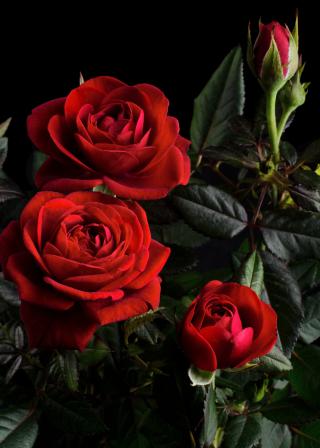Flower gardening is the horticulturist's reward for hard work. Flowers and flower borders provide color against the predominant green of a landscape. They are the accent and contrast that make a landscape lively and interesting. Flowers also complement most of the features that conventional landscaping materials, such as trees and shrubs, establish. They can add depth and dimension, form and texture, and change heights and slopes, besides their most obvious asset which is color. Flowers can also be useful, providing culinary herbs for the table and cut flowers for arrangements.
Flowers

Question:
When my roses bloom they have brown and black petal edges and are deformed. Also the leaves are sticky. Some of the leaves are covered with yellow spots mixed with the green color of the leaves. What is causing these problems and what can I do?
Answer
Your roses have two insect problems and a virus. The flower petals are brown or black because of a very small insect called the western flower thrip, Frankliniella occidentalis (Pergande). Adult thrips are about 1/8, (2 mm), in length, usually tan-to-dark brown-bodied, with four feather like wings. The young or nymphs are creamy white and wingless and develop into adults in about two weeks. The adults enter a rose bud and lay eggs inside the immature flower. The eggs hatch and the resulting nymphs and adults injure the plant by rasping the bud, flower and leaf tissue of host plants and then suck the exuding sap. This causes petal tissue to die and results in brown or black petal edges. Thrips also affect other flower, fruit and vegetable plants. These include apples and peaches which result in surface damage to the fruit. Onions, snap beans, chrysanthemums, gladiolus and iris are also damaged by other thrips species. There has been many more thrips the last couple of years because of the above normal rainfall which has provided abundant wildflower and weed crops for the thrips to live on and thus increased populations. The other insect problem is aphids. These small insects are yellow to green in color and suck sap from plants that they infect. The "sugars" which they do not metabolize are excreted and fall onto the leaves of the plant. This is the sticky, shiney substance that you see. Sometimes ants and flies will "milk" aphids for this exudate and feed on it. So if ants are spotted on plants there is a good chance that aphids are present. The yellow marks mixed with the green color of the leaves is a virus or a complex of several viruses. The spotted yellow-green leaf color is known as mottling and is very symptimatic of viruses. These viruses generally do not kill the plant but can weaken it."
Several insects are predators of thrips and aphids. These include ladybird beetles and their larva, minute pirate bug and lacewings. Thrips have alternate hosts of weeds and wildflowers. By controlling host plants thrip populations will be lowered. Because thrips do damage inside the rose buds a systemic insecticide should be used. There are several products on the market which control thrips and aphids systemically. Sometimes disystox, a systemic insecticide, is included in rose fertilizer. Always follow label directions when applying pesticides. To reduce the problems of viruses in plants purchase virus-indexed or certified virus free plants. Virus infected plants can be a source of infection that can be transmit to healthy plants by aphids or other insects. Therefore, control the aphids and other insects vectors to control the spread of virus diseases.
Insect Pests of Farm, Garden and Orchard. 7th Ed. R. H. Davidson and W. F. Lyon. pp. 305-6, 311-12.
Question:
The leaves of my roses are drying up. The leaves have a white-grayish fuzzy material coating them. What is this and what can I do?
Answer
Powdery mildew is affecting roses. Powdery mildews are common, widespread, and on many crop and ornamental plants. The total loss by these organisms each year probably surpass the losses caused by any other single type of plant disease. There are many species of powdery mildew. Your apple tree was probably infected by Podosphoera leucotricha and your roses by Spaerotheca pannosa. These fungi are common and cause serious problems in cool and warm humid areas, but are even more of a problem in warm dry climates like Arizona. Powdery mildew spores (fungal seeds"), can be released, germinate, and cause infection when the relative humidity in the air is fairly high, but there is no film of water on plant surface. This spring, with abnormally high rainfall, has favored the growth and spread of powdery mildew. Once infection has begun the fungus spreads on plant surfaces regardless of the moisture conditions in the atmosphere. These organisms send haustoria (feeding organs), into the epidermal cells of plants to obtain nutrients. Powdery mildews are obligate parasites; meaning they cannot be cultured on artificially growing media in the laboratory but must grow on the their specific hosts. Powdery mildew seldom if ever kills its host but utilize their nutrients, reduce photosynthesis, increase respiration and transpiration, impairs growth, and can reduce yields as much as 20-40 percent."
When planting roses or other susceptible plants place them in location with good sunlight and air flow, i.e. not up against the house. Prune plants properly to open them up to ensure air flow through the plant. A rose or euonymus planted on the shady north side of a house will surely have powdery mildew problems. Many new rose varieties have disease resistance to powdery mildew. This resistance will help, but may not completely eliminate the need for chemical control. Chemical controls include spraying or dusting sulfur. Care must be taken not to apply sulfur on hot days because plant tissue can be burned. Other chemical controls include benomyl (Benlate), triadimefon (Bayleton) and triforine (Funginex).
Plant Pathology, George N. Agrios. Third Edition, 1988, pp. 337-342.

